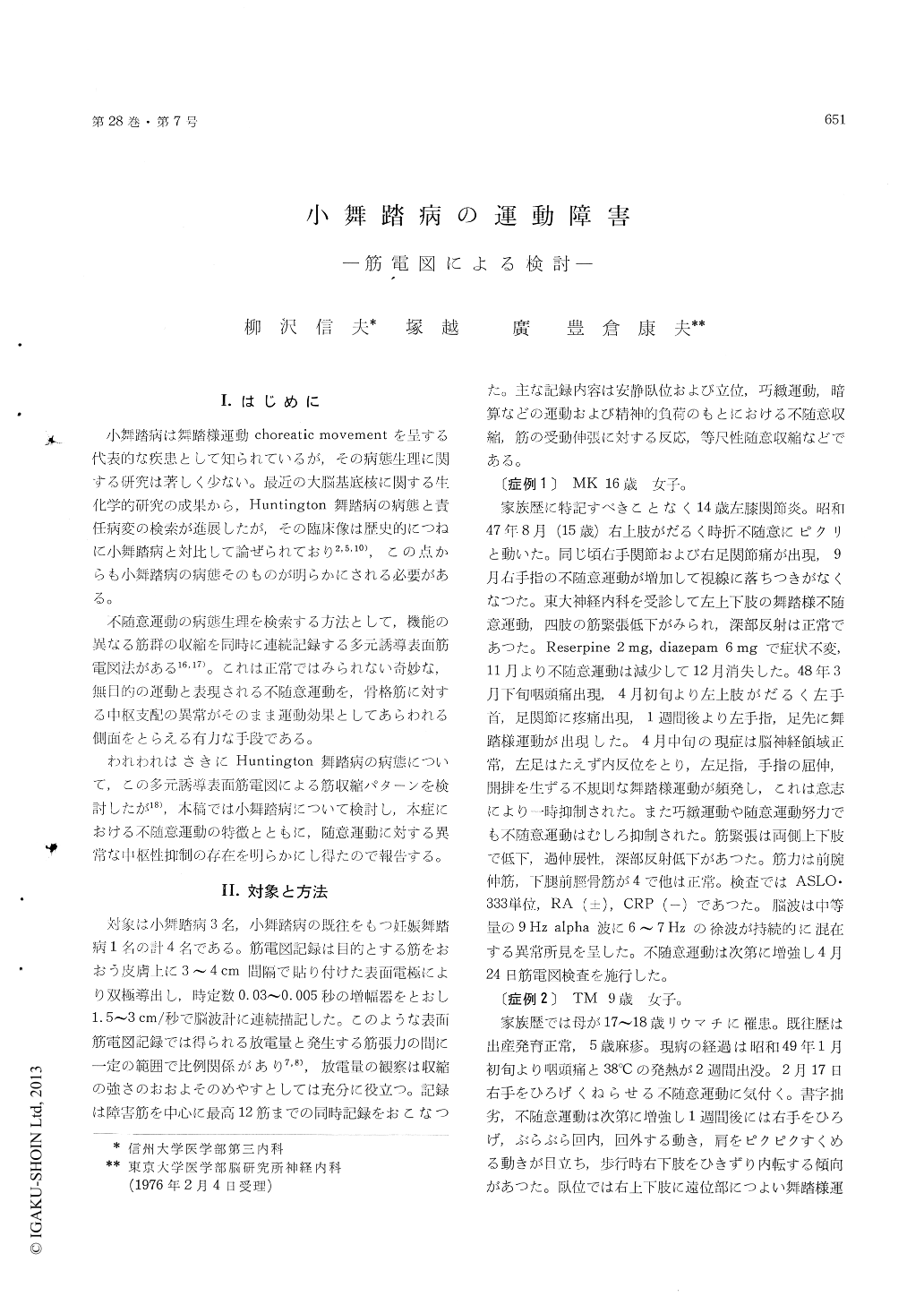Japanese
English
- 有料閲覧
- Abstract 文献概要
- 1ページ目 Look Inside
I.はじめに
小舞踏病は舞踏様運動choreatic movementを呈する代表的な疾患として知られているが,その病態生理に関する研究は著しく少ない。最近の大脳基底核に関する生化学的研究の成果から,Huntington舞踏病の病態と責任病変の検索が進展したが,その臨床像は歴史的につねに小舞踏病と対比して論ぜられており2,5,10),この点からも小舞踏病の病態そのものが明らかにされる必要がある。
不随意運動の病態生理を検索する方法として,機能の異なる筋群の収縮を同時に連続記録する多元誘導表面筋電図法がある16,17)。これは正常ではみられない奇妙な,無目的の運動と表現される不随意運動を,骨格筋に対する中枢支配の異常がそのまま運動効果としてあらわれる側面をとらえる有力な手段である。
Electromyogram was recorded from affected muscles of the trunk and extremities of three cases with Sydenham's chorea (8, 9 and 16 years old females) and one case with chorea gravidarum with anamnesis of Sydenham's chorea (22 year old female).
Surface electrodes were used for simultaneous recordings from many functionally different muscle groups up to twelve and a 13 channel inkwriting oscillograph with amplifiers with time constants of 0.03-0.005 sec was used. Involuntary contractions at rest or during standing or in the course of skilled motion, response to passive stretch of muscles and isometric voluntary contractions were examined. Following results were obtained and compared with electromyogram of motor disorders in Huntington'schorea.
1) Phasic bursts of action potentials were ob-served in affected muscles in all cases corresponding to choreic movements. Distal parts of extremities were more severely affected. Agonists and antag-onists contracted independently or reciprocally in three cases. This was the same pattern as observed in Huntington's chorea with muscular hypotonia. Another case (case 1) with most frequent spells of involuntary movements showed simultaneous con-tractions in agonists and antagonists.
Size and shape of compound action potentials in phasic contractions were similar to that of Huntington's chorea. Therefore, more brusque and flinging movements in Sydenham's chorea than Huntington's chorea may not be attributable to difference in pattern of contractions itself. More marked hypotonia of affected muscles in Sydenham's chorea may be responsible for flinging, large move-ments.
2) Passive stretch of extremity muscles by ma-nipulation evoked no response in most cases. Only case 1 showed paradoxical contractions of Westphal in pretibial and quadriceps muscles. Simultaneous contractions in flexors and extensors in phasic in-voluntary movements with paradoxical contractions by muscle stretch, which were observed in case 1, were common findings in Huntington's chorea without muscular hypotonia.
3) In a case with chorea gravidarum tendon taps of biceps brachii muscle provoked contractions in forearm flexors, forearm extensors and thigh muscles successively. Tendon taps in other muscles or photic or sonic stimulations were ineffective. Significance of this widespread muscular contractions by biceps tendon tap was discussed in relation to startle response or spino-bulbo-spinal reflex.
4) Sudden brief relaxation of muscles during sustained voluntary contraction was observed in all cases. Coincidentally sudden brief abolishment of action potentials of agonists was observed without any active contractions in their antagonists or neighboring muscles. Same finding was obtained in Huntington's chorea but it was more typical in Sydenham's chorea. Thus in Sydenham's chorea, as in Huntington's chorea, not only the active in-voluntary contraction but also the active inhibition of innervation should be considered as a component of its motor disorders.

Copyright © 1976, Igaku-Shoin Ltd. All rights reserved.


